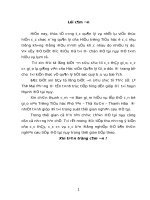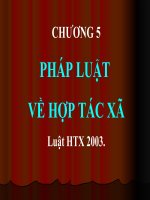CMV tại Pháp_Tiếng Pháp
Bạn đang xem bản rút gọn của tài liệu. Xem và tải ngay bản đầy đủ của tài liệu tại đây (580.94 KB, 19 trang )
<span class='text_page_counter'>(1)</span><div class='page_container' data-page=1>
Seronegativity
Seroconversion
Fetal infection
Symptomatic
neurological impairment
Parity
50%
10%
60%
0,37%
* nouveau-nés infectés
2960/an
12,7%
symptomatiques
376/an
60%
avec déficit cognitif ± auditif
225/an
87,3%
asymptomatiques
2584/an
13,5%**
avec déficit auditif
349/an
</div>
<span class='text_page_counter'>(2)</span><div class='page_container' data-page=2>
Seronegativity
Seroconversion
Fetal infection
Symptomatic
neurological impairment
Parity
50%
10%
</div>
<span class='text_page_counter'>(3)</span><div class='page_container' data-page=3>
Seronegativity
Seroconversion
Fetal infection
Symptomatic
neurological impairment
Parity
50%
10%
60%
Prevention of seroconversion:
• No vaccine available
– Best overall efficacy was 50%
1• Hygiene and behavioural interventions
– Logical but uncertain efficacy on
seroconversion rate
2,31 <sub>Pass RF, N Engl J of Medicine, 2009, 360: 1191-99,</sub>
2 <sub>Adler et al, J Pediatrics, 2004, 145: 485-91,</sub>
</div>
<span class='text_page_counter'>(4)</span><div class='page_container' data-page=4>
Seronegativity
Seroconversion
Fetal infection
Symptomatic
neurological impairment
Parity
50%
10%
60%
Secondary prophylaxis by
Hyperimmune globulin prophylaxis
•
One exploratory study: Risk reduction / fetal
infection of 24%
1•
One randomized, double-blinded, placebo
controlled study: NS risk reduction
2•
One ongoing trial in the US, adequately sized
3</div>
<span class='text_page_counter'>(5)</span><div class='page_container' data-page=5>
Brain
<sub>Hematopoiesis</sub>
Liver, spleen
Placenta
Vessels
Growth
Multisystemic disease
Ultrasound
Amniocentesis
Fetal blood sampling
MRI
Full prognostic assessment
Seronegativity
Seroconversion
Fetal infection
Symptomatic
neurological impairment
Parity
50%
10%
</div>
<span class='text_page_counter'>(6)</span><div class='page_container' data-page=6>
Extracranial imaging
Placentitis
Oligohydramnios / <i>Polyhydramnios</i>
Hyperechoic bowel
Meconial peritonitis /Ascites
Liver & Spleen enlargement
Ubiquitous Calcifications
Pericardial / Pleural Effusion
Dilated Myocarditis
Heart Calcifications
Hydrops
Growth Restriction / Small for GA
Seronegativity
Seroconversion
Fetal infection
Symptomatic
neurological impairment
Parity
50%
10%
</div>
<span class='text_page_counter'>(7)</span><div class='page_container' data-page=7>
Ventriculomegaly
Parenchymal calcifications
Sub-ependymal Cysts
Calcifications of lenticulostriate v.
Intraventricular septation
Periventricular Hyperechogenicity
Periventricular cysts
Cystic Periventricular leukomalacia
Abnormal Gyration / Lissencephaly
Polymicrogyria
Microencephaly
Microcephaly
Intracranial symptoms imaging
Seronegativity
Seroconversion
Fetal infection
Symptomatic
neurological impairment
Parity
50%
10%
</div>
<span class='text_page_counter'>(8)</span><div class='page_container' data-page=8>
Petechiae
IUGR
Hepato-splenomegaly
Microcephaly
Jaundice
Fo
w
le
r 1
99
2
Petechiae
IUGR
Hepato-splenomegaly
Microcephaly
Jaundice
Auditory tests
Platelets/liver tests
Transcranial US
Re
vi
se
d
de
fini
tio
n
</div>
<span class='text_page_counter'>(9)</span><div class='page_container' data-page=9>
Seronegativity
Seroconversion
Fetal infection
Symptomatic
neurological impairment
Parity
50%
10%
60%
Leruez-Ville, AJOG 2016
Non-severe US
anomalies
N=22
No US anomalies
N=41
TOP (severe) n=3
Symptomatic n=11
Asymptomatic n=8
TOP (severe) n=3
Symptomatic n=0
Asymptomatic n=38
AF PCR+, 20-28 wks
N=82 Severe brainN=19
Symptomatic n=9
Asymptomatic n=10 Symptomatic n=0Asymptomatic n=38
delivery
<b>Intracranial anomalies</b>
Intraventricular adhesions
Lenticulostriate
vascuolpathy
Subependymal cysts
Calcifications
<b>Extracranial anomalies</b>
Hepatosplenomegaly
Placentomegaly
IUGR
Hyperechoic bowel
Edema
</div>
<span class='text_page_counter'>(10)</span><div class='page_container' data-page=10>
Seronegativity
Seroconversion
Fetal infection
Symptomatic
neurological impairment
Parity
50%
10%
60%
Leruez-Ville, AJOG 2016
1 10 100
Platelets & Viremia*
Non-severe US
Symptomatic at birth
Ultrasound and biology are
independant predictors
*viral load > 5 log or platelets < 115000/mm3
PPV = 50%
NPV = 100%
N=53
</div>
<span class='text_page_counter'>(11)</span><div class='page_container' data-page=11>
Seronegativity
Seroconversion
Fetal infection
Symptomatic
neurological impairment
Parity
50%
10%
60%
Leruez-Ville, AJOG 2016
Mid-trimester assessment
AF PCR+
Severe brain
N=19
Who should we treat?
No US anomalies
FBS anomalies*
* High viral load or low platelets
Non-severe US
anomalies
</div>
<span class='text_page_counter'>(12)</span><div class='page_container' data-page=12>
AJOG 2016
Good maternal tolerance
In vitro: ValACV is <b>not</b> the most efficient drug against CMV
Best safety profile:
No cell transformation, no increase risk of neoplasia in vitro
No association with an increased risk of birth defects in thousand of women
exposed in pregnancy [Stone et al, 2004; Pasternak, JAMA, 2010]
PK/PD [Jacquemard, BJOG 2009]:
Good placental passage, therapeutic fetal concentrations
Possible impact on viral load and platelets in infected fetuses
Clinical efficacy: <b>high</b> valACV dosage (2gx4/day) has proved efficient to prevent
CMV disease in transplanted patients [Lowance et al,N Engl J Med 1999].
But
CYMEVAL 2
Phase 2: Valacyclovir for the infected fetus
ValACV 2g x 4 / day for > 6 weeks
</div>
<span class='text_page_counter'>(13)</span><div class='page_container' data-page=13>
<b>Severe cerebral anomalies</b>
Ventriculomegaly ≥ 15mm
Hydrocephalus
Microcephaly (HC<3SD)
Megacysterna magna >10 mm
Vermian hypoplasia
Porencephaly
Lissencephaly
Abnormal corpus callosum
INCLUSION EXCLUSION
<b>Extra-cerebral anomalies </b>
Intrauterine growth restriction (IUGR)
Abnormal amniotic fluid volume
Ascites and/or pleural effusion
Skin edema
Hydrops
Placentomegaly > 40 mm
Hyperechogenic bowel
Hepatomegaly > 40 mm
Splenomegaly > 30 mm
Liver calcifications
<b>Non-severe cerebral anomalies</b>
Moderate ventriculomegaly (<15 mm)
Isolated cerebral calcifications
Isolated intraventricular adhesion
Calcifications of lenticulate vessels
<b>Biological anomalies</b>
Fetal viremia > 3000 copies/ml
Fetal platelets < 100 000/mm3
<b>Contra-indication to ValACV</b>
AJOG 2016
CYMEVAL 2
Phase 2: Valacyclovir for the infected fetus
</div>
<span class='text_page_counter'>(14)</span><div class='page_container' data-page=14>
Primary outcome: symptomatic at birth
Petechiae
IUGR
Hepato-splenomegaly
Microcephaly
jaundice
Fo
w
le
r 1
99
2
Petechiae
IUGR
Hepato-splenomegaly
Microcephaly
Jaundice
Auditory tests
Platelets/liver tests
Transcranial US
Re
vi
se
d
de
fini
tio
n
AJOG 2016
CYMEVAL 2
Phase 2: Valacyclovir for the infected fetus
</div>
<span class='text_page_counter'>(15)</span><div class='page_container' data-page=15>
CYMEVAL 2
Failure of CYMEVAL 1
Double-blinded placebo-controlled RCT
ValACV vs. placebo in moderately
symptomatic infected fetuses
</div>
<span class='text_page_counter'>(16)</span><div class='page_container' data-page=16>
Phase 2 design: to test the effect of ValACV against a plausible estimate
P0 = non acceptable proportion of asymptomatic infants < 60%
P1 = acceptable proportion of asymptomatic infants ≥ 80%
2-step Simon design (α=5%, Power=80%):
First step: 11 cases
If at least 7 / asymptomatic, continue up to 43 cases
AJOG 2016
CYMEVAL 2
Phase 2: Valacyclovir for the infected fetus
</div>
<span class='text_page_counter'>(17)</span><div class='page_container' data-page=17>
<b>Characteristics</b>! <b>Median-</b>[<b>Interquartile-range</b>]<b>-or-(%)</b>!
<b>Women-(N=41)</b>! !
<b>---Parity-</b>≥<b>-1</b>! 30!(73.2)!
<b>---Gestational-age-at-primary-infection-(wks)</b>! 10![7.8–16.2]!
<b>---Gestational-age-at-inclusion-(wks)</b>! 25.9![24.1–31.7]!
<b>---Interval-between-primary-infection-and-inclusion-(wks)</b>! 16![12.3–18.6]!
<b>Fetuses-(N=43)</b>! !
<b>---Fetal-blood-CMV-DNA-load->-3000-copies/mL</b>! 3!(7)!
<b>---Fetal-growth-restriction-no.-(%)</b>! 3!(7)!
<b>---Abnormal-amount-of-amniotic-fluid-no.-(%)</b>! 3!(7)!
<b>---Ascites-and/or-pleural-effusion-no.-(%)</b>! 1!(2.3)!
<b>---Placentomegaly-no.-(%)</b>! 13!(30.2)!
<b>---Hyperechogenic-bowel-n-(%)</b>! 25!(58.1)!
<b>---Hepatomegaly-no.-(%)</b>! 6!(14)!
<b>---Splenomegaly-no.-(%)</b>! 9!(20.9)!
<b>---Liver-calcification-no.-(%)</b>! 1!(2.3)!
<b>---Moderate-cerebral-abnormality-n-(%)</b>! 5!(11.6)!
! !
AJOG 2016
CYMEVAL 2
Phase 2: Valacyclovir for the infected fetus
</div>
<span class='text_page_counter'>(18)</span><div class='page_container' data-page=18>
! First!Step! Second!Step!
Outcome! ! !
Asymptomatic!neonates! 8!! 34!!
Symptomatic!neonates!or!TOP!! 3!! 9!!
Total! 11! 43!
!
CYMEVAL 2
Phase 2: Valacyclovir for the infected fetus
AJOG 2016
ValACV is a potential effective therapy in
moderately symptomatic fetuses
</div>
<span class='text_page_counter'>(19)</span><div class='page_container' data-page=19>
CYMEVAL 2
Phase 2: Valacyclovir for the infected fetus
Cymeval 2: limitations
1. ValACV is not the best antiviral drug
2. Non-randomized
3. Over-estimation of severity?
Cymeval 3
</div>
<!--links-->









